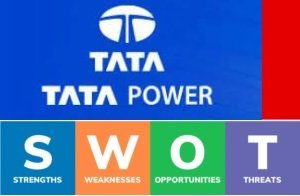SWOT Analysis of Tata Power – Tata Power SWOT Analysis focuses on the strengths, weaknesses, opportunities, and threats.

Tata Power is one of the largest integrated power companies in India and a part of the Tata Group, one of India’s most respected conglomerates. Founded in 1910, Tata Power has a rich heritage and has played a significant role in powering India’s growth over the years. The company is headquartered in Mumbai, Maharashtra.
Tata Power has a diversified portfolio of power generation assets, including thermal power plants, hydroelectric power plants, solar power plants, and wind farms. It operates in various segments of the power sector, including generation, transmission, distribution, and trading. The company has a total installed capacity of over 14,076 megawatts (MW) and serves millions of customers across different segments, including residential, commercial, and industrial.
One of the notable strengths of Tata Power is its focus on renewable energy. The company has been actively expanding its renewable energy portfolio and has set ambitious targets for clean energy generation. It has made significant investments in solar and wind power projects, contributing to India’s renewable energy transition and sustainability goals. Tata Power is also involved in the development of energy storage solutions to enhance grid stability and support the integration of renewable energy sources.
Tata Power has a strong brand reputation and benefits from being a part of the Tata Group, which is known for its commitment to ethical business practices, social responsibility, and sustainability. The company has a widespread distribution network, operating in multiple states across India, and has a well-established presence in both urban and rural areas.
However, Tata Power also faces challenges, including regulatory uncertainties, high capital expenditure requirements, and risks associated with fuel imports for its thermal power plants. The company continues to adapt to the changing regulatory landscape and explore opportunities for growth and innovation in the power sector.
Overall, Tata Power is recognized as a key player in the Indian power industry, contributing to the country’s energy security and sustainable development goals. It continues to strive for excellence in power generation, transmission, and distribution, while also embracing clean and renewable energy sources to meet the evolving needs of its customers and the growing demand for sustainable power solutions.
Strengths in the SWOT Analysis of Tata Power
- Diverse Power Generation Portfolio: Tata Power has a diverse portfolio of power generation assets, including thermal, hydro, solar, and wind power plants. This diversity reduces its dependence on a single source of energy and enhances its resilience to market fluctuations and regulatory changes.
- Strong Brand Reputation: Tata Power is part of the Tata Group, one of India’s most respected and well-known conglomerates. The company benefits from the strong brand reputation and trust associated with the Tata name, which helps in attracting customers, investors, and strategic partners.
- Extensive Distribution Network: Tata Power has an extensive distribution network that allows it to reach a wide customer base. The company operates in multiple states across India, providing electricity to residential, commercial, and industrial consumers. This widespread presence provides a competitive advantage and revenue stability.
- Focus on Renewable Energy: Tata Power has been actively expanding its renewable energy portfolio and has set ambitious targets for clean energy generation. Its focus on renewables aligns with the growing global demand for sustainable and environmentally friendly power sources, positioning the company for long-term growth and compliance with regulatory requirements.
Weaknesses in the SWOT Analysis of Tata Power
- Regulatory Challenges: The power sector in India is subject to complex and frequently changing regulations. Tata Power faces challenges related to policy uncertainties, tariff regulations, and land acquisition for power projects. Adapting to evolving regulatory environments can pose risks and create delays or additional costs for the company.
- High Capital Expenditure Requirements: Power generation projects, especially those involving renewable energy, often require substantial upfront investments. Tata Power’s capital expenditure requirements for expanding its generation capacity or upgrading existing infrastructure can strain its financial resources and increase its debt burden.
- Dependence on Fuel Imports: Tata Power relies on imported coal for its thermal power plants, which exposes the company to risks associated with fluctuating fuel prices, currency exchange rates, and geopolitical uncertainties. This dependence can impact the company’s profitability and operational flexibility.
Opportunities in the SWOT Analysis of Tata Power
- Renewable Energy Growth: The global push towards renewable energy presents significant opportunities for Tata Power. The company can leverage its expertise and experience in the sector to expand its renewable energy portfolio further. Increasing government support and favorable policies for clean energy in India and globally provide a conducive environment for growth.
- Energy Storage Solutions: With the growing integration of intermittent renewable energy sources, energy storage solutions are gaining importance. Tata Power can explore opportunities in energy storage technologies, such as battery storage systems, to enhance grid stability, support renewable energy integration, and provide ancillary services.
Threats in the SWOT Analysis of Tata Power
- Intense Competition: The power sector in India is highly competitive, with both public and private players vying for market share. Tata Power faces competition from other established utilities, independent power producers, and emerging players. Intensified competition can put downward pressure on tariffs and reduce profit margins.
- Price Volatility: The power industry is susceptible to price volatility, particularly in fuel costs. Fluctuating prices of imported coal or natural gas can impact Tata Power’s operational costs and financial performance. Additionally, regulatory changes in electricity tariffs and subsidy structures can affect the company’s revenue stability.
- Environmental and Social Concerns: Increasing environmental and social awareness has led to greater scrutiny of the power sector’s impact on the environment and local communities. Tata Power needs to address concerns related to emissions, land acquisition, and community engagement to maintain its social license to operate and mitigate reputational risks.
If you like this article you can recommend your friends about PROJECTS4MBA.COM
If you like This Article Please Like our Facebook Page PROJECTS4MBA

